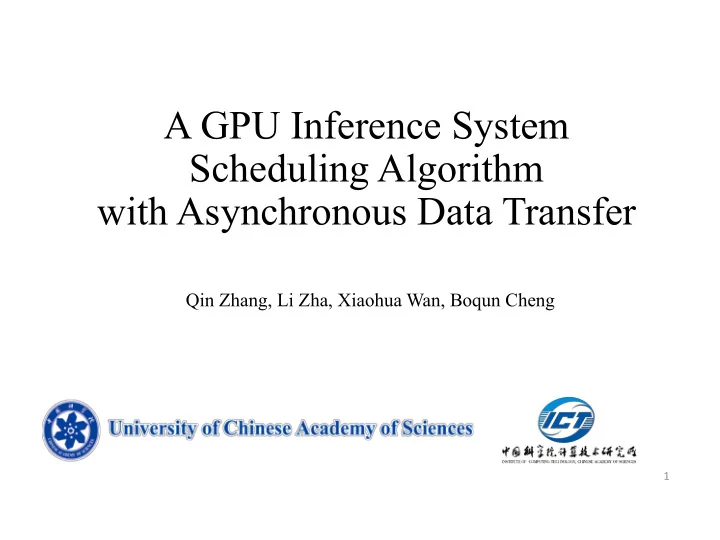

A GPU Inference System Scheduling Algorithm with Asynchronous Data Transfer Qin Zhang, Li Zha, Xiaohua Wan, Boqun Cheng 1
Contents • Background • Related Works • Motivation • Model • Scheduling Algorithm • Experiments • Conclusion & Future Work 2
Background • Deep Learning Inference – Small jobs, High concurrence, Low latency – Strong correlation with actual applications – Low attention compare with training • General Purpose GPU computing – Widely used in Deep Learning – Suitable for computing intensive jobs – Somewhat different from CPU when it comes to scheduling jobs 3
Related Works • Clipper[crankshaw2017clipper] – Dynamic match the batch size of inference jobs. • LASER[agarwal2014laser] – Presented by LinkedIn for online advertising using cache system. • FLEP[wu2017flep] – Accelerate GPU utilization ratio through kernel preemption and kernels scheduling with interruption skills.
Related Works • [tanasic2014enabling] – Use s set of hardware extensions to support multi- programmed GPU workloads. • Anakin[Baidu org] – Automatic graph fusion, memory reuse, assembly level optimization.
Motivation • No model can describe inference jobs’ processing mode quantitatively . • Computation and data transmission execute serially, leading to low GPU utilization ratio. • Question: – How to quantitatively analysis the relationship between concurrency and latency? – How to make full use of GPUs with their characteristics?
Model • Latency: batch filling time + GPU processing time ! " # = max ( " # , * "+, - + * " # • batch filling time: batch size / concurrency ( # = #/0 1 • GPU processing time: upload time + calculation time + download time, linear with data size(batch size). * # = 2 34 # + 2 5675 # + 2 89:; #
Model • The relationship between batch size and upload time, calculation time and download time. ! " = $" + & Upload time Calculation time Download time
Model • Batch size selection: #$ % ! = 1 − ($ % • Upper bound of concurrency $ % = 1/( • Limits of concurrency with given latency upper bound and batch size selection. $ % = 1 ( − 2# ( ∗ 1 ! = , − 2# , , 2(
Model • If job scheduling system supports GPU data transfer and computation asynchronous execution. # $ = max ) ! " " $ + + ,-," $ , / "01 2 + + 3453," $ • Batch size selection: (7 3453 − 7 ,- ): ; $ = 1 − (= 3453 − = ,- ): ; • Upper bound of concurrency : ; = 1/(= 3453 − = ,- )
Model • Limits of concurrency with given latency upper bound and batch size selection 1 2- &'(& ∗ 1 ! " = − % &'(& − % *+ % &'(& − % *+ / 0 = / − 2- &'(& 2% &'(& • The time to upload new batch to GPU memory. 12 345 = 6780 395 − : ;<=>,395 + : &'(&, 3 − : *+, 345
Scheduling Algorithm • Start two CUDA stream to use up the asynchronous capability of GPU. • Select two different batch sizes to initial the model’s parameters. • Scheduling algorithm records recent several batches’ GPU time, and updates the parameters. • Calculate batch size according to real time concurrency and latency requested, and upload it to GPU memory ahead of last batch returning to host memory.
Scheduling Algorithm • When concurrency increases – Batch will be filled ahead of schedule – Upload current filled batch – Update concurrency – Select new batch size with new concurrency, the remaining time of current processing batch and the GPU processing time of newly uploaded batch – Scheduling System adapts to new concurrency dynamically.
Scheduling Algorithm • When concurrency decreases – Batch will not be filled when it’s time to upload it. – Force the completion of the batch filling phase and upload the smaller batch. – Update concurrency – Select new batch size with new concurrency and the calculation time of newly uploaded batch – Scheduling System adapts to new concurrency dynamically.
Experiments(environment) CPU Intel(R) Core(TM) i5-8600 CPU @ 3.10GHz Memory 32GB GPU GTX 1080Ti GPU memory 11GB Operation System Ubuntu 16.04 Platform PyTorch 1.0.0 Model ResNet-50 Dataset CIFAR10
Experiments(concurrency changing) GPU processing time batch size latency throughput
Experiments(concurrency increasing) GPU processing time batch size latency throughput
Experiments(concurrency decreasing) GPU processing time batch size latency throughput
Experiments(concurrency-latency) • Latency surges when concurrency increases under baseline and our scheduling algorithm. • Our algorithm can slow down the increase of latency evidently(The larger the concurrency, the more obvious the effect).
Experiments(peak clipping) • Double the concurrency and keep 0.3s. • Our algorithm can reduce the peak of batch size and job latency. • Our algorithm can clip the latency peak of concurrency and smooth the throughput. throughput
Conclusion • Improve the processing capacity of the system by 9%. • Reduces the latency by 3%-76% under different concurrency. • Reduce the peak of latency by 16% when concurrency bursts from 400pic/s to 800pic/s for 0.3 second. • Clip the peak of concurrency and smooth the throughput.
Future Work • Is this method feasible in distributed system which have network communication delay? • In deep learning training, we can also increase GPU utilization rate by making data transfer and computing asynchronously.
Q & A Thanks!
Recommend
More recommend